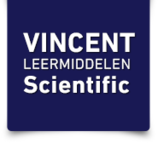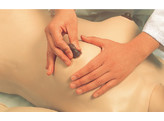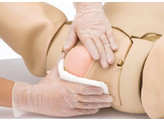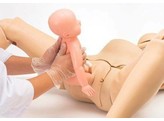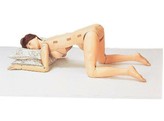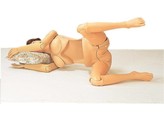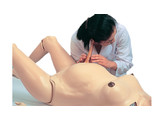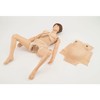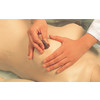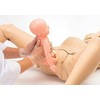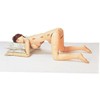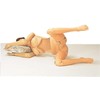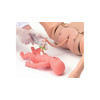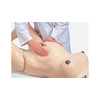By interchanging various parts, procedures such as external examination of a
pregnant woman, internal examination during stages of delivery, practical
obstetric assistance, perineal suture of soft birth canal lacerations, palpation of
the uterus fundus during the puerperal peirod, and breast care can be
practiced. Obstetric assistance can be practiced on the model in either a supine
or free-style position.
Features -
Obstetric Abdominal Palpation Model
Renewal - New material New abdominal wall sheet that is softer and more elastic.
Representing 36th to 40th weeks of pregnancy.
Visual diagnosis, palpation and abdominal measurements (abdominal girth, fundal height) according to the four types of Leopold's Maneuvers, monitoring of fetal heartbeats, and breast care can be practiced.
Changing the position and orientation of the fetus enables diagnosis in various fetal positions and orientations, and diagnosis of stability and mobility of the fatal presenting part.
The fetal heartbeat can be adjusted between 80 and 180 bpm.
Vaginal Examination Model
Renewal - New material Vaginal Examination Model Vulva II is mode from a highly elastic and soft material that gives the feeling of the vaginal wall surrounding the finger.
The ischial spine and pubic symphysis can be felt.
Bishop scores from the late stage of pregnancy to the onset of labor (cervical dilation, effacement, consistency and position) can be confirmed.
Three models with varying degrees of uterus opening dilation are provided, along with a model of the fetal head. These can be interchanged and the degree of engagement of fetal head can be adjusted, making it possible to gauge the progression of labor by means of vaginal examination.
The fetal head model can be used to gauge rotation of the fetal head by varying positions of the sagittal sutures and posterior fontanel.
The vulva has a urethral orifice for inserting a urinary catheter.
Obstetric Assistant Model
Renewal - New material The obstetric model - vulva II is made with a highly elastic and durable material that decreases resistance and reduces the amount of force needed to extract the fetus during delivery, enabling smooth practice. (Use glycerin to lubricate.)
Protection of the perineum can be practiced.
Breech extraction can also be practiced as one type of emergency response.
Renewal - New material The umbilical cord is soft and slides away from scissors when being cut, so that each one can be used multiple times to practice tying and cutting. The fetal model and placenta model can be attached to practice the entire sequence of steps from delivering the fetus to tying the umbilical cord, cutting the umbilical cord, and delivering the placenta.
The placental membrane laceration part can be detached into three parts for inspection of the placenta and checking whether or not the membrane is intact.
Perineal Suture Model
This model enables confirmation of the perineal laceration position and level of laceration, and practice in preparing for and performing a suture.
Use of forceps can also be practiced.
Puerperal Uterus Palpation Model
Four kinds of puerperal uterus models are provided (normal and abnormal conditions on the first day, normal conditions on the third day and on the fifth day). These can be interchanged for diagnosis of progress in recession of the uterus through palpation and measurement of the abdominal area.
Breast Model
This model enables basic training in breast care, including breast and nipple palpation, inspection of breast mobility, and nipple massage.
Flexibility and mobility of the entire breast allows palpation of the mammary glands.
pregnant woman, internal examination during stages of delivery, practical
obstetric assistance, perineal suture of soft birth canal lacerations, palpation of
the uterus fundus during the puerperal peirod, and breast care can be
practiced. Obstetric assistance can be practiced on the model in either a supine
or free-style position.
Features -
Obstetric Abdominal Palpation Model
Renewal - New material New abdominal wall sheet that is softer and more elastic.
Representing 36th to 40th weeks of pregnancy.
Visual diagnosis, palpation and abdominal measurements (abdominal girth, fundal height) according to the four types of Leopold's Maneuvers, monitoring of fetal heartbeats, and breast care can be practiced.
Changing the position and orientation of the fetus enables diagnosis in various fetal positions and orientations, and diagnosis of stability and mobility of the fatal presenting part.
The fetal heartbeat can be adjusted between 80 and 180 bpm.
Vaginal Examination Model
Renewal - New material Vaginal Examination Model Vulva II is mode from a highly elastic and soft material that gives the feeling of the vaginal wall surrounding the finger.
The ischial spine and pubic symphysis can be felt.
Bishop scores from the late stage of pregnancy to the onset of labor (cervical dilation, effacement, consistency and position) can be confirmed.
Three models with varying degrees of uterus opening dilation are provided, along with a model of the fetal head. These can be interchanged and the degree of engagement of fetal head can be adjusted, making it possible to gauge the progression of labor by means of vaginal examination.
The fetal head model can be used to gauge rotation of the fetal head by varying positions of the sagittal sutures and posterior fontanel.
The vulva has a urethral orifice for inserting a urinary catheter.
Obstetric Assistant Model
Renewal - New material The obstetric model - vulva II is made with a highly elastic and durable material that decreases resistance and reduces the amount of force needed to extract the fetus during delivery, enabling smooth practice. (Use glycerin to lubricate.)
Protection of the perineum can be practiced.
Breech extraction can also be practiced as one type of emergency response.
Renewal - New material The umbilical cord is soft and slides away from scissors when being cut, so that each one can be used multiple times to practice tying and cutting. The fetal model and placenta model can be attached to practice the entire sequence of steps from delivering the fetus to tying the umbilical cord, cutting the umbilical cord, and delivering the placenta.
The placental membrane laceration part can be detached into three parts for inspection of the placenta and checking whether or not the membrane is intact.
Perineal Suture Model
This model enables confirmation of the perineal laceration position and level of laceration, and practice in preparing for and performing a suture.
Use of forceps can also be practiced.
Puerperal Uterus Palpation Model
Four kinds of puerperal uterus models are provided (normal and abnormal conditions on the first day, normal conditions on the third day and on the fifth day). These can be interchanged for diagnosis of progress in recession of the uterus through palpation and measurement of the abdominal area.
Breast Model
This model enables basic training in breast care, including breast and nipple palpation, inspection of breast mobility, and nipple massage.
Flexibility and mobility of the entire breast allows palpation of the mammary glands.
Eigenschappen
- 803982
